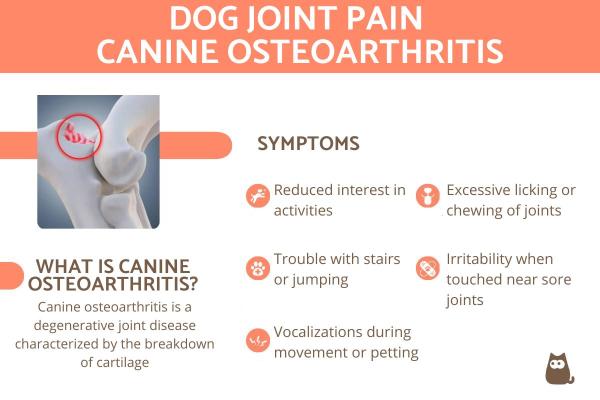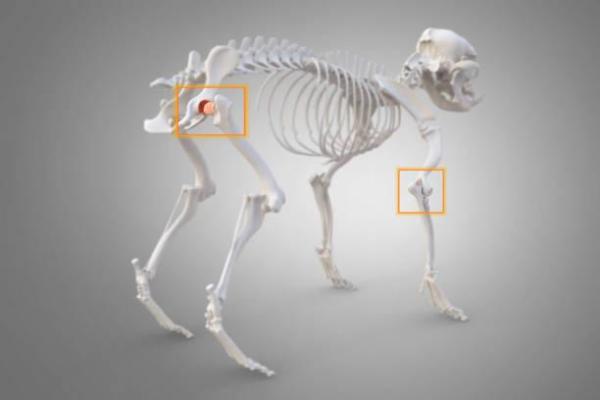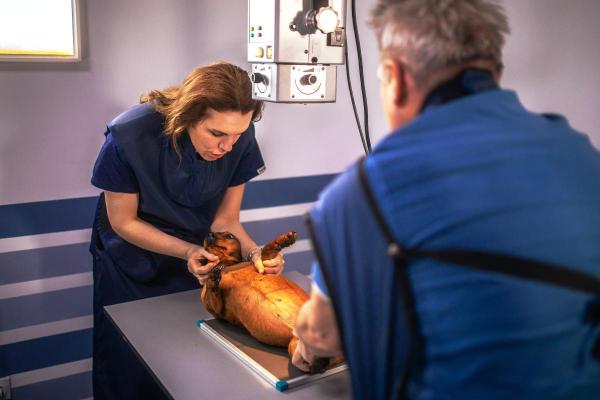Is Your Dog Limping? Understanding Canine Osteoarthritis



See files for Dogs
Does your furry friend seem less enthusiastic about walks or struggle to jump on the couch? Limping can be a concerning sign in dogs, and sometimes it might point to a common condition called canine osteoarthritis (OA). Early recognition and management of OA are crucial for maintaining your dog's well-being.
This AnimalWised article explains what osteoarthritis in dogs is, its symptoms, diagnosis, treatment options and more.
What is osteoarthritis in dogs?
Canine osteoarthritis (OA) is a widespread degenerative joint disease that affects roughly 25% of dogs. It's a painful condition that progressively breaks down cartilage, the cushioning material within joints. This breakdown leads to bone hardening (sclerosis) and the formation of bony spurs (osteophytes) around the joint, hindering movement and causing discomfort.

Symptoms of osteoarthritis in dogs
Osteoarthritis in dogs often starts subtly. Initially, you might notice your dog becoming less enthusiastic about exercise, particularly activities that require jumping or climbing stairs. These initial signs can be easy to miss, especially in older dogs, who naturally slow down with age.
Knowing how your dog normally behaves and moves is key to detecting potential discomfort from OA. Here are some common indicators to watch for:
- Less enthusiasm for playtime or walks they used to enjoy.
- Increased grumpiness or irritability, especially when touched around sore joints.
- Vocalizations like whining or yelping when moving or being petted in certain areas.
- Difficulty climbing stairs, jumping on furniture, or getting into the car.
- Lameness or limping, which may worsen with exercise.
- Stiffness, especially after rest or upon rising.
- Visible swelling or redness around joints.
- Loss of muscle mass around affected areas.
- Licking or chewing excessively at specific joints.
As the condition advances, lameness can become more pronounced.

Types of osteoarthritis in dogs
Osteoarthritis in dogs can vary based on the location of the degenerative changes. Common types include:
- Hip osteoarthritis: often observed in dogs with hip dysplasia. It can cause difficulty rising, stiffness in the hind legs, and pain when the hip is extended.
- Shoulder osteoarthritis: it limits a dog's range of motion in the forelimb, making it difficult to fetch objects, climb stairs, or jump.
- Knee osteoarthritis: more prevalent in dogs with knee trauma or patellar dislocation. It can cause lameness, limping, and difficulty bending the knee.
- Elbow osteoarthritis: frequently seen in dogs with elbow dysplasia. Signs include lameness, favoring the affected leg, and difficulty extending the elbow.
- Dorsal osteoarthritis: affecting the cervical or thoracic vertebrae. It can cause neck pain, stiffness, and difficulty turning the head.
- Lumbar osteoarthritis: impacting the lumbar and/or sacral vertebrae. It can cause back pain, stiffness, and difficulty jumping or climbing stairs.
These types reflect the diverse locations where osteoarthritis can develop in dogs, often influenced by underlying conditions or injuries.
Causes of osteoarthritis in dogs
Osteoarthritis in dogs can develop due to two main categories of causes:
Primary Osteoarthritis:
This is less common and the exact cause is often unknown (idiopathic). It's thought to be related to genetics and age-related degeneration of the cartilage.
Certain breeds may be predisposed due to their genetic makeup, especially large and giant breeds such as german shepherds, labradors, golden retrievers, rottweilers, great danes, newfoundlands (all commonly affected by hip & elbow dysplasia).
Secondary Osteoarthritis:
This is the more frequent type, arising from other underlying conditions that damage the joint. Common causes include:
Developmental orthopedic diseases:
- Hip dysplasia and elbow dysplasia (malformation of hip and elbow joints)
- Patellar luxation (dislocation of the kneecap)
Joint injuries:
- Fractures
- Ligament tears
- Obesity
Other orthopedic conditions:
- Intervertebral disc disease (IVDD) can contribute to osteoarthritis in the spine.
By understanding these causes, you can help reduce your dog's risk of developing osteoarthritis. Maintaining a healthy weight, providing moderate exercise, and addressing any injuries promptly are all important preventative measures. Don't forget to check out this other article for exercises specifically designed for dogs with hip dysplasia.

Diagnosis of osteoarthritis in dogs
Diagnosing canine osteoarthritis typically involves a combination of history-taking, physical examination, and imaging tests. Here's how these tests are commonly used:
- Physical examination: the veterinarian will conduct a thorough examination of the dog, paying close attention to the affected limbs and joints. They will assess for signs of pain, swelling, thickening, and loss of muscle mass, which are indicative of osteoarthritis.
- Diagnostic imaging: X-rays (radiography) are often the initial imaging modality used to diagnose osteoarthritis. They can reveal changes such as osteophytes (bone spurs) and joint degeneration. However, X-rays may have limited ability to visualize soft tissues. In such cases, other imaging techniques like magnetic resonance imaging (MRI) may be used to assess soft tissue structures. Additionally, computed tomography (CT) scans can provide detailed images of bone changes, particularly in joints with complex anatomy like the elbows, tarsi, and carpus.

Treatment of osteoarthritis in dogs
Osteoarthritis in dogs does not have a cure, and treatment focuses on managing symptoms to improve the dog's quality of life. Here's a breakdown of the key points regarding the treatment of canine osteoarthritis:
- Control of body weight: excess weight can exacerbate osteoarthritis symptoms, so maintaining a healthy weight is important to reduce joint stress and inflammation.
- Change in daily activity: adjusting the dog's activity level to reduce high-impact activities while maintaining regular, low-impact exercise helps preserve muscle mass and joint stability.
- Rehabilitation: some dogs may benefit from rehabilitation therapies such as water exercises, joint flexibility exercises, acupuncture, or laser therapy to alleviate symptoms and improve mobility.
- Surgery: in certain cases, surgical interventions may be necessary to address the underlying causes of osteoarthritis, such as ligament ruptures or joint deformities.
- Medications: various medications, including nonsteroidal anti-inflammatory drugs (NSAIDs), corticosteroids, analgesics, and joint supplements like omega-3 fatty acids, chondroitin sulfate, and glucosamine, can help control pain and inflammation.
- Joint modulators: these include treatments like polysulfated glycosaminoglycans (PSGAG), platelet-rich plasma injections, corticosteroid injections, hyaluronic acid injections, or stem cell therapy, which aim to improve joint health and function.
Ultimately, the veterinarian will determine the most appropriate treatment options based on the individual needs and circumstances of each dog affected by osteoarthritis. For further information, you can also read this article on physical therapy for dogs with arthritis.
Prognosis of osteoarthritis in dogs
The prognosis for dogs with osteoarthritis (OA) isn't a one-size-fits-all answer. It depends heavily on several factors, but the good news is that with proper management, many dogs with OA can live happy, comfortable lives for years to come.
The lifespan of a dog with osteoarthritis can vary greatly depending on several factors:
- Severity of the condition: more severe cases will naturally have a greater impact on a dog's mobility and overall well-being.
- Treatment plan: dogs receiving only pain medication (conservative treatment) may have a shorter lifespan or limited mobility.
It's important to remember that seeking veterinary care as soon as possible for an accurate diagnosis and appropriate treatment plan is crucial. With proper management, osteoarthritis doesn't have to define your dog's life.
This article is purely informative. AnimalWised does not have the authority to prescribe any veterinary treatment or create a diagnosis. We invite you to take your pet to the veterinarian if they are suffering from any condition or pain.
If you want to read similar articles to Is Your Dog Limping? Understanding Canine Osteoarthritis, we recommend you visit our Degenerative diseases category.
- Zaera, J.P. (2022). Traumatology in small animals . Grupo Asís Biomedia, SL
- Fernández, T. (2001). Osteoarthritis in Dogs . Available at: https://www.agrovetmarket.com/investigacion-salud-animal/pdf-download/la-osteoartritis-en-el-perro









